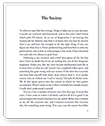Essay Instructions: S501 Structured Critical Reflection Paper #1?A Pre-Assignment: In preparation for this written assignment you are to read the following:
Shipler, D. (2005). The working poor: Invisible in America. New York: Vintage
Walls, J. (2005). The glass castle. New York: Scribner.
This paper is to be an integration of your critical thinking (see intellectual standards for critical thinking, p. 3) and reflections, inclusive of your feelings, beliefs, values, self-awareness, and related claims as supported by the assigned readings and supportive literature. Be mindful that critical thinking is, ?the art of analyzing and evaluating thinking with a view to improving it? (Paul & Elder, 2006, p. 4). Gibbs and Gambrill (2005) define critical thinking as ?a unique kind of purposeful thinking in which we use standards such as clarity and fairness. It involves the careful examination and evaluation of beliefs and actions in order to arrive at well-reasoned decisions? (p. 11). It is thinking about our thinking processes and being explicit as well as transparent about those processes in order to facilitate improved thinking for learning. Many good ideas are not communicated because authors fail to think about the purpose of the assignment. Good writing is a reflection of good thinking.
Your paper is to take the above definitions into consideration as you reflect and write utilizing the intellectual standards for critical thinking (www.criticalthinking.org). The paper is worth a total of 10 points and is due on September 16th. You must use APA 6th Edition for the appropriate format, citations, and referencing of your paper. The paper should be at least 5 pages and absolutely no more than 7 pages in length. You will need to be concise ? don?t waste words summarizing the texts ? you may assume that your instructor has read both books! We want you to REFLECT on them. You may write in first person (?I?), however, this is to be a scholarly work. Suggested supportive text: Encyclopedia of Social Work (NASW, 2008) to be helpful. A grading rubric is provided and you must turn in a completed grading rubric (self-assessment) with your paper?papers will not be accepted for grading without a completed rubric.
*The paper utilizes the DEAL (Ash & Clayton, 2004) model of critical reflection. The paper should have 4 distinct sections (headings) as well as 4 sub-sections within the Articulate Learning section (be sure to use APA levels for sub-headings) as delineated below. Papers that do not address the entire model, inclusive of all sections and questions, will not be viewed as a completed assignment. The paper should include the 4 sections below:
I. Describe: In detail and as objectively (honestly) as possible, describe your experience reading the texts. This is not to be a book report or rehash of the text, but is to be an objective (honest) description of your experience (understanding & knowledge) with the text. Your experience may include gut reactions, questions provoked, and how the texts affected your thinking about the poor. You should begin this section with ?In preparation for this reflection paper, I read the texts, reflected on my life experiences, and then identified the following key themes in my experience reading the texts ??
II. Examine: Identify specific aspect of the text that captured your attention, thoughts, and/or feelings. In this section, you are to relate your personal/professional experiences, as appropriate and relevant, that illustrate the concepts the authors discuss (in the context of scholarly reflection). This must be addressed in the context of the following questions (notice that these primarily relate to objective # 3 in your syllabus):
What forms of discrimination, and oppression (sexism, racism, heterosexism, ageism, classism, and/or ableism) did you observe in the experiences discussed by the authors? What societal challenges (bureaucracy, income, health care, child care) contributed to the experiences? What role do you think race and/or ethnicity plays with regard to poverty?
III. Articulate Learning: This is a 4-part structure requires a fair amount of reflective thought. The DEAL model (describe, examine, articulate learning) is an assignment designed to generate, document, and deepen your learning (Ash & Clayton, 2004). This last, 4-part section is critical to the entire process. Simplistic and reductionistic answers are inadequate. For example it is not enough to say, I learned about poverty among the working poor by reading the texts and It matters because it is important to social work and in the future I will be more empathic of others. These examples do not exhibit critical thinking?these statements merely report and poorly at that. Use sub-headings for this section of the paper as well. The 4-part structure for this section includes:
a. What did I learn?
b. How did I learn it?
c. Why does it matter?
d. What will I do in the future, in light of the learning?
IV. A brief summary paragraph.
Summarize your thoughts and conclusions.
Note about grading: An A grade, 10 points, is viewed as exceptional work as demonstrated by a well developed discussion exhibiting a broad range of knowledge as well as critical thinking. A passing grade is a C (average work). Only papers below a C will be allowed a re-write and only to bring the grade to a passing C (7.7?7.5 points), therefore writers scoring 7.1 points or below will be allowed to re-write and re-submit your paper. This will be allowed for this initial writing assignment only. Late papers will result in a loss of points.
Grading Scale:
100-98% A+ 97-95% A 94-92% A-
91-88% B+ 87-85% B 84-82% B-
81-78% C+ 77-75% C 74-72% C-
71-68% D+ 67-65% D 64-62% D-
61-0% F
References
Ash, S.L., Clayton, P.H. (2004). The articulated learning: An approach to guided reflection and
assessment. Innovative Higher Education, 29(2), 137-154.
Gibbs, L. & Gambrill, E. (2005). Critical thinking in clinical practice: Improving the quality of
judgments and decisions (2nd ed.). Hoboken, NJ: John Wiley and Sons.
Paul, R., & Elder, L. (2006). The miniature guide to critical thinking and tools. Dillon Beach,
CA: Foundation for Critical Thinking.
Intellectual Standards* for Critical Thinking Description Questions
Clarity Clearly stated ideas with detail in the descriptions that serve to clarify statements. Are my ideas clearly stated and are my examples of the topic clear to the reader? Did I provide examples? Can I elaborate?
Accuracy Statements or claims that are supported with evidence (citations) and are factually correct. Did I support my claim with evidence? How do I know this to be truthful? How can I validate my claim? Did I use too much anecdotal experience to support my claim?
Relevance Statements that are key to the primary thesis and connect to a central point. Are my statements connected to the topic? How is what I discussed of concern to the overall issue?
Depth The discussion and conclusions reflect the complexity of the issue. Have I covered the complexity of the issue? Are there other themes that need to be explored to do the issue justice?
Logic Reasoning that makes sense and conclusions that are in keeping with statements made throughout the discussion. Does the introduction match my conclusions? Did I put forth and follow a line of thought that makes sense? Are my conclusions a reflection of the complexity of the issue discussed?
Breadth The discussion reflects multiple viewpoints and possibilities. What would another perspective include? Is there another way to interpret this? Did I research alternative perspectives? Can I turn my discussion upside down for a different vantage point?
*see www.criticalthinking.org
S501: Grading Rubric Structured Critical Reflection #1
You must self-evaluate your paper in accordance with this grading rubric. The completed rubric must accompany your paper. Evaluate each section, circling the designated box in accordance with your self-evaluation. IS* stands for?Intellectual Standards for Critical Thinking (see page 3).
Section evaluated A
2?points B
1.8?points C
1.6?points D?F
1.35-0?points
Describe Description with clarity, accuracy, & relevance using objectivity and coherence in relating the experience of reading the texts. Description is clear, accurate & demonstrates objectivity in relating the experience of reading the texts. Some detail with clarity and objectivity, but lacks consistency throughout section. Significant lack of detail, objectivity, and evidence of disjointed presentation of section.
Examine Identification of relevant issues presented with clarity & accuracy. Questions explored & discussed with, depth, breadth, and logic. All claims are supported with evidence. Identification of a issue and explored with clarity. Some depth & breadth in the discussion. Claims are supported. Some identification of an issue, thoughts, feelings & beliefs are not clearly examined, with at least 2 IS*. Issue thoughts, feelings & beliefs are not clearly examined with little evidence to support claims or little to no utilization of IS*.
Articulate Learning All aspects of the 4-part structure are fully addressed and clear evidence of learning is articulated with IS* fully evidenced. All aspects of the 4-part structure are addressed and some evidence of learning is articulated with IS*. Most aspects of the 4-part structure are addressed and some evidence of learning is articulated, but inconsistent IS*. Aspects of the 4-part structure are unclear and little evidence of learning is articulated with no IS*.
Use of APA style & format Grammar, APA style and format are used correctly throughout the paper. Only minor problems with grammar & APA style and format. Most of the paper uses correct grammar & APA style and format. Many problems with grammar and/or APA style. e.g., no page numbers for direct quotes.
General quality of writing Paper is very well written, organized in accordance with the assignment, no errors in grammar, spelling, and punctuation. Paragraphs and sentences are well developed and clear. Paper is well written, very few errors in grammar, spelling, and punctuation. Paragraphs and sentences are developed. Paper is generally well written and organized with some problems with grammar, spelling, and punctuation. Some lack of clarity. Paper is not very well written. Many problems with grammar, spelling, and punctuation
*IS?critical thinking standards
Student comments: Student Score________
(Please provide comments to support your score and claims)


